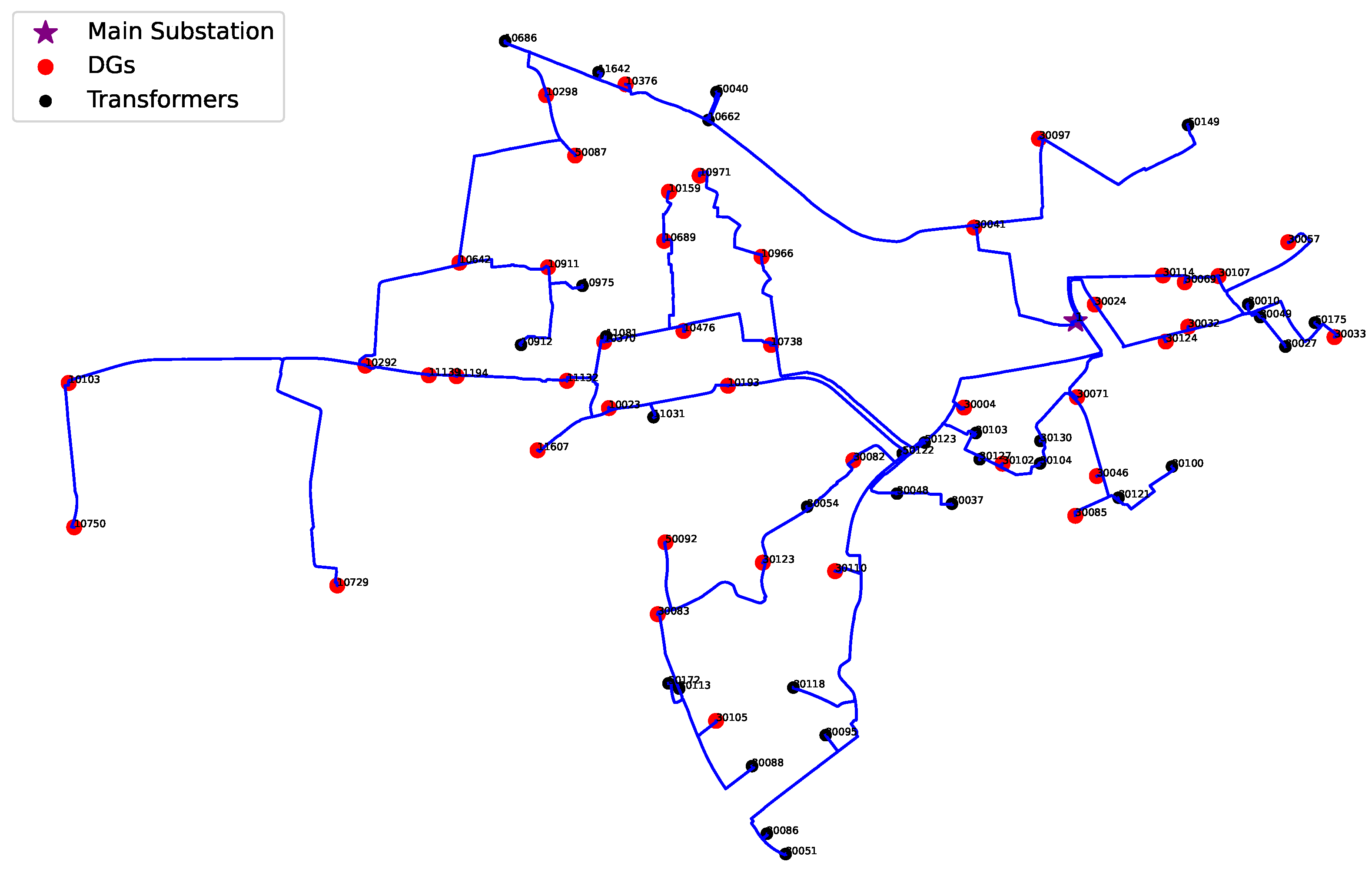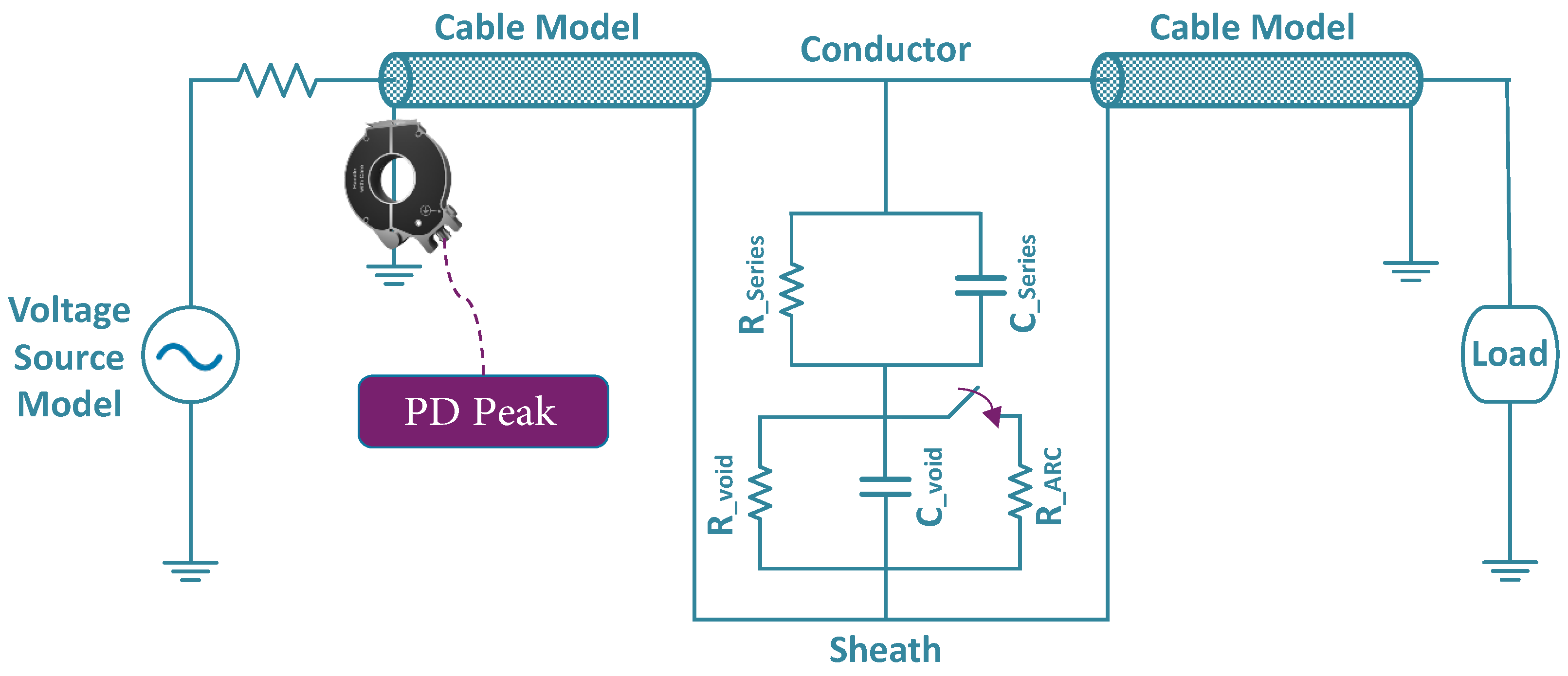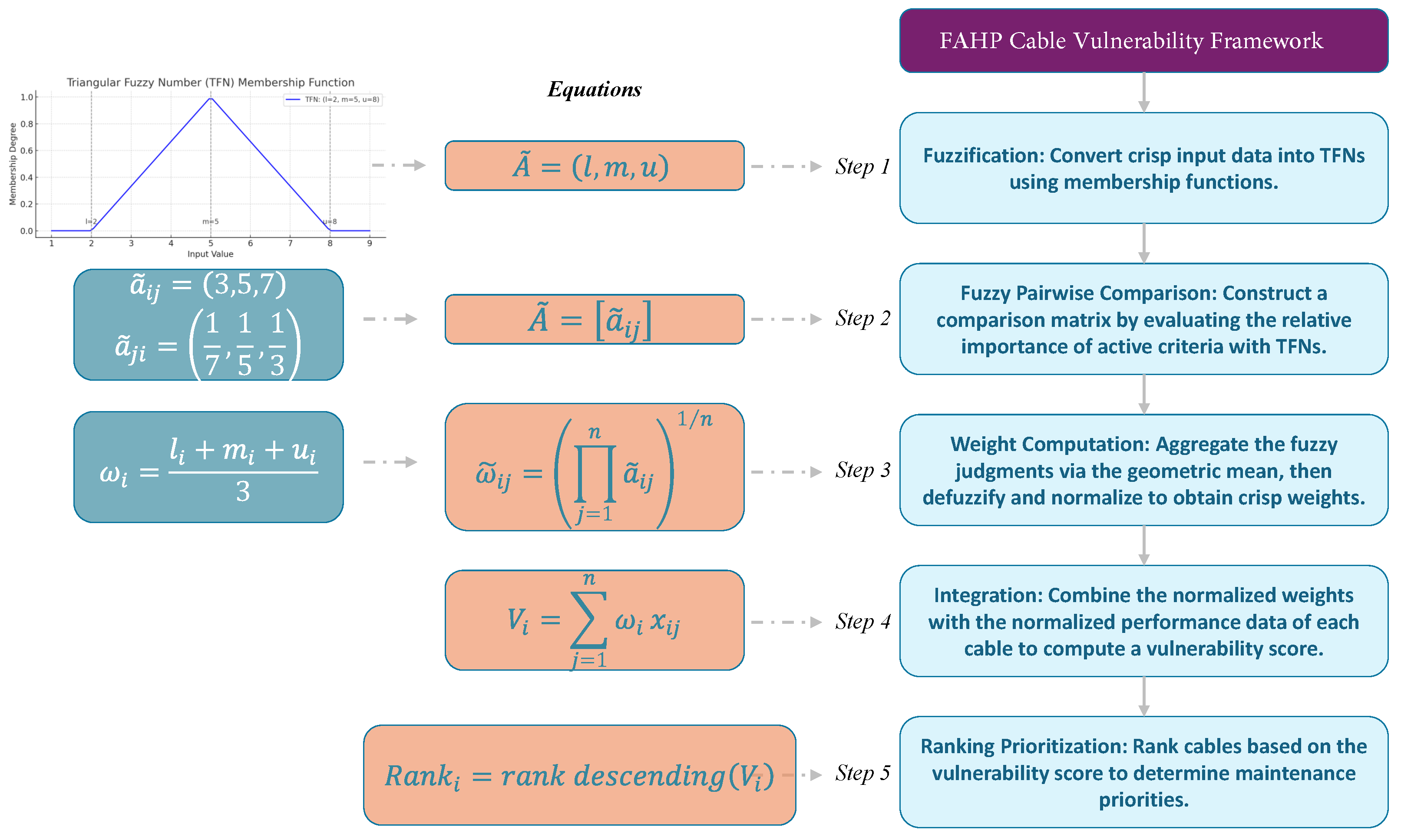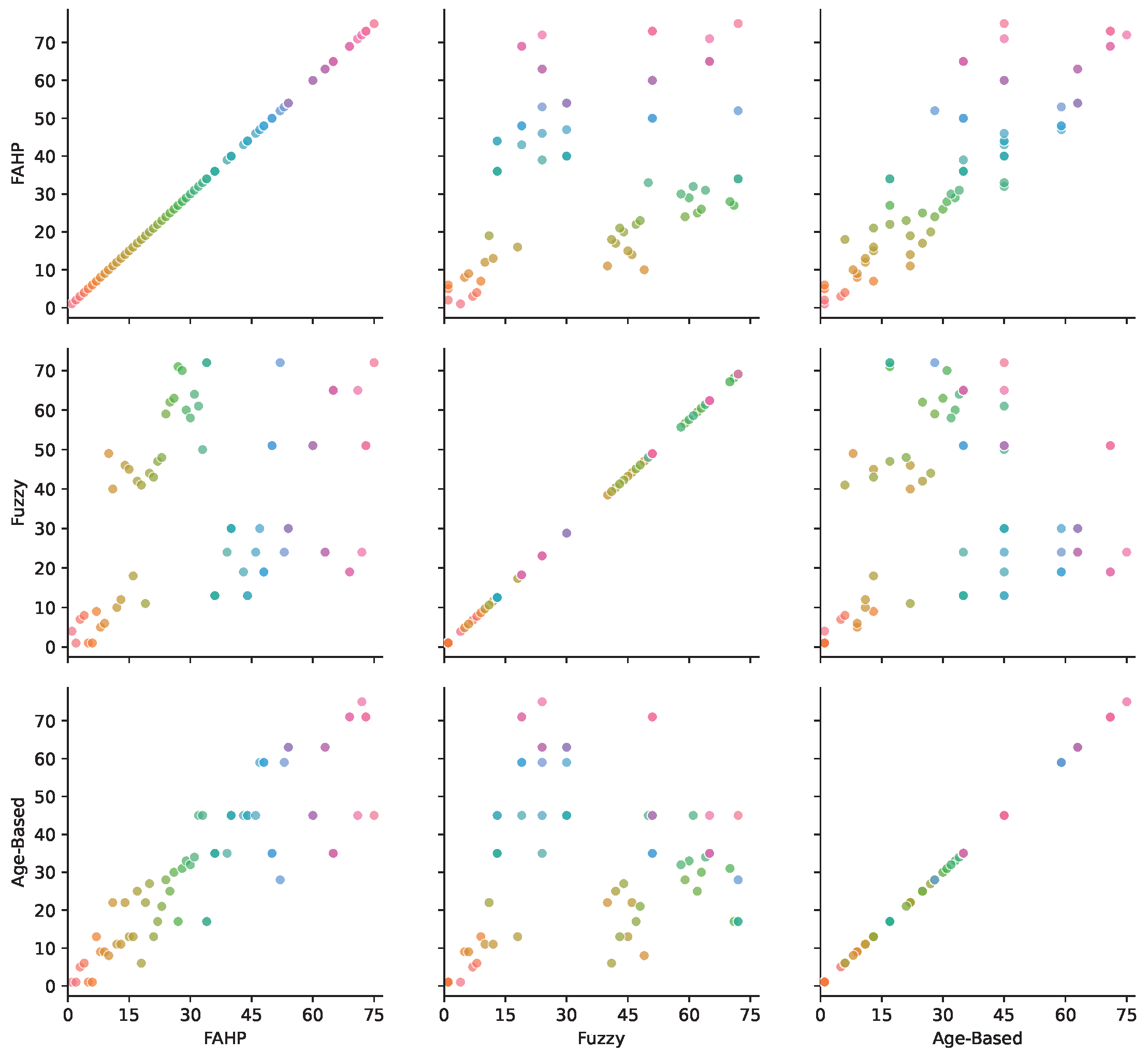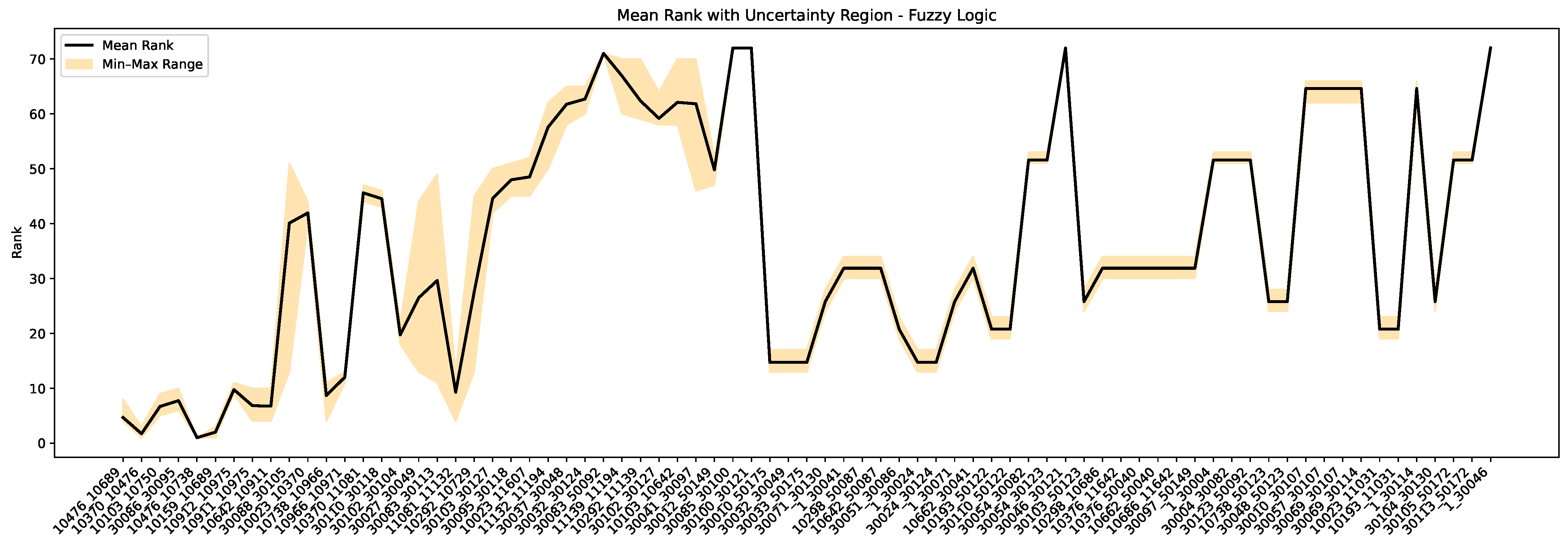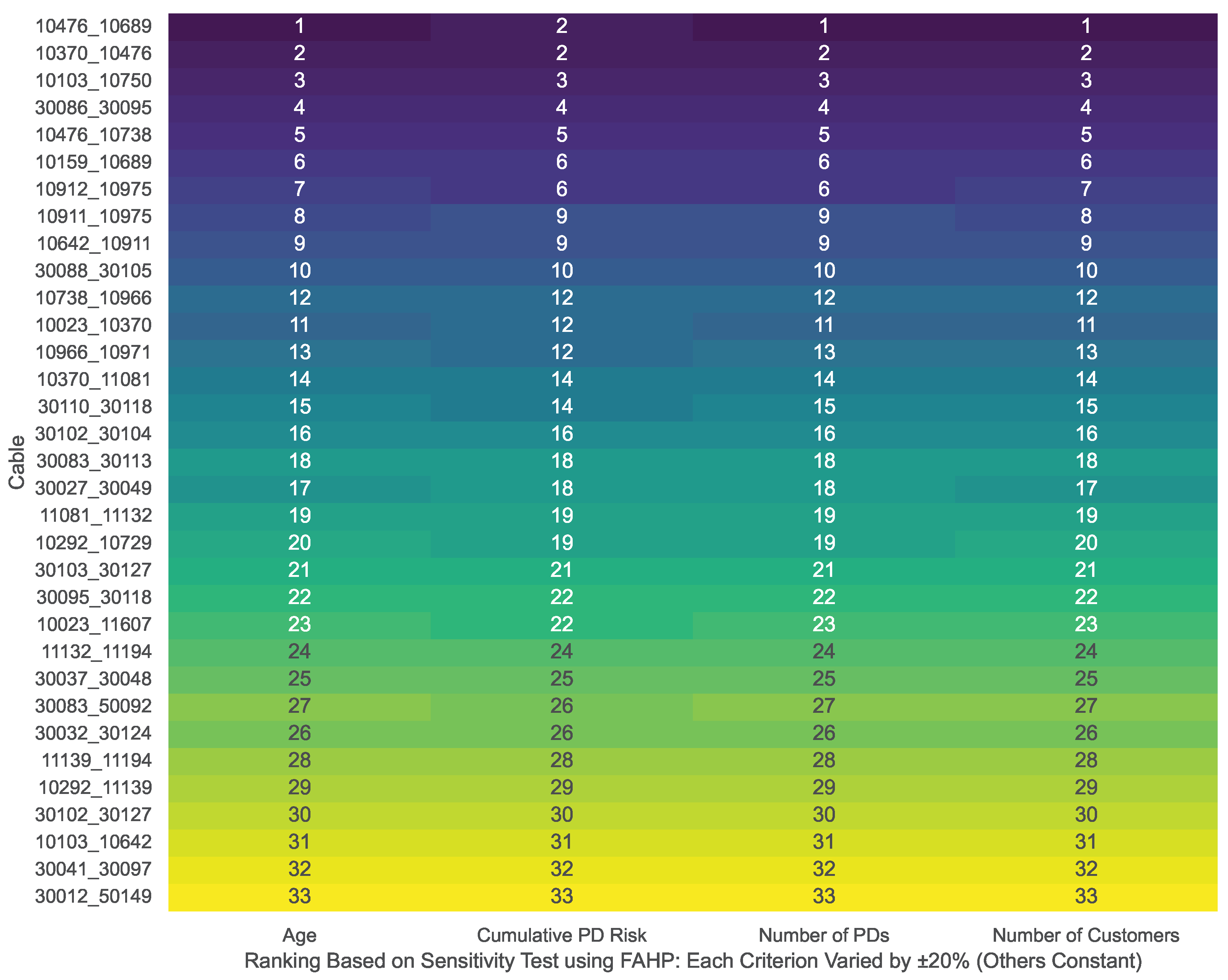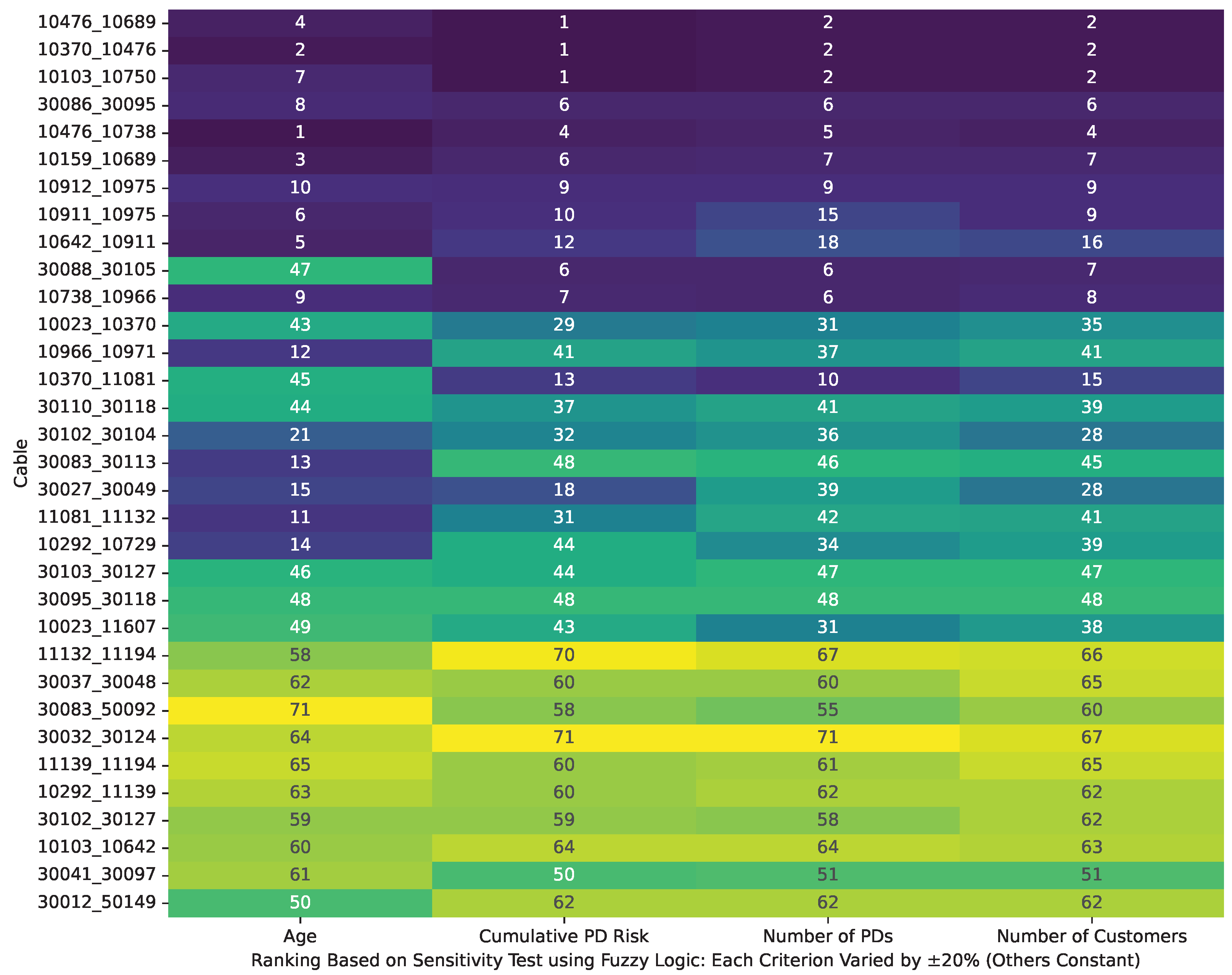1. Introduction
The worldwide aging of buried cable infrastructure poses a critical power system reliability issue, one that raises the risk of insulation failure and power outages. With approximately 10,000–12,000 km of lead-armored (APB) 10/20 kV cables installed primarily between the 1960s and 1970s, Denmark exemplifies the global issue of cable assets exceeding their designed lifespan of 30–35 years, beyond which their vulnerability to faults increases sharply [
1]. Similarly, Sweden operates more than 437,000 km of underground cables, most of which have used cross-linked polyethylene (XLPE) insulation since the 1970s [
2]. However, these cables can experience practical issues such as water tree formation, moisture ingress into the insulation, and other defects, all of which contribute to accelerated aging.
Several physics-of-failure models, such as thermal–oxidative aging, water tree growth, electrical tree propagation, and multi-stress Eyring models, have been developed to predict cable insulation degradation from laboratory-based offline testing. For example, the authors in [
3] conducted thermal and corrosion degradation testing with the application of accelerated stress under controlled laboratory conditions on samples that underwent a destructive analysis. On the other hand, PD measurements, as standardized in IEC 60270, yield continuous, non-intrusive, and online condition monitoring, which renders PD particularly suitable and practical for utility-scale, network-wide cable management.
Although failures can occur due to various factors, PD remains one of the most recognized indicators of insulation degradation in aging cables. Today, utilities have initiated massive replacement schemes to upgrade old APB and XLPE cables, particularly those evidencing PD activity. However, due to the substantial capital investments and operational complexities associated with such replacements, cable section ranking based on the history of fault occurrences and PD characteristics is essential.
Conventionally, cable replacement has been a simple, age-based strategy, where the oldest cables are replaced first. But this is costly in large electrical networks with thousands of cable sections. Moreover, this replacement approach does not guarantee safety or reliability. A younger cable showing early signs of deterioration can pose a more immediate threat to network integrity than an older cable maintained in proper condition.
Much like human health, a cable’s longevity depends on its environment and operational factors such as soil composition, temperature, moisture levels, loading conditions, manufacturing quality, and installation procedures, which can either accelerate aging or preserve functionality beyond expectations [
4]. This is why utilities are moving away from reactive guesswork and adopting proactive, condition-based approaches.
The prioritization of cable replacement, as well as awareness of the age of the cable, relies further on a perception of the historic fault statistics and activity of PD. The detection and analysis of PD activities, however, are technically challenging and depend on a good-quality sensor and successful interpretation of the signal. To support this, various PD measurement techniques have been developed for both offline and online applications. Electrical methods, such as the pulse current method [
5], capacitive coupling [
6], ultra-high-frequency (UHF) detection [
7,
8], and electromagnetic coupling [
9], offer different trade-offs in terms of sensitivity, frequency response, and ease of installation. In addition, non-electric techniques like acoustic emission [
10,
11] and fiber optic [
12] sensing offer utility where electromagnetic interference may hinder detection, and they are practical solutions to discharge source location. These techniques enable a more informed and targeted approach to cable condition monitoring and replacement scheduling [
13,
14].
Each PD measurement method has its own pros and cons. For example, ultrasonic sensing often struggles with signal loss and noise over long distances. To improve detection, newer systems place sensors along the cable to catch signals closer to where the problem occurs. These sensors are synchronized using LFM signals, which removes the need for GPS or fiber optics and still allows for accurate fault location [
15].
Table 1 presents various sensors used for online PD detection in cables, along with their main advantages and limitations.
Meanwhile, machine learning is changing the way we understand PD signals. Instead of manually interpreting complex waveforms, models like 1D convolutional neural networks and graph-based algorithms can now learn the patterns hidden in noise, making it easier to identify the type of fault [
16,
17]. Alongside this, topological data analysis offers a new way of looking at PD signals. Visible patterns act to give a better indication of the slight differences between faults that would otherwise be missed, thus improving detection accuracy and reliability. However, as these AI models are often black boxes, explainable AI is essential to ensure transparency and trust [
18].
Table 1.
Overview of PD detection sensors [
13,
19].
Table 1.
Overview of PD detection sensors [
13,
19].
| Category | Sensor Type | Application Area | Frequency Range | Advantages | Disadvantages |
|---|
| Pulse Current Method | Coupling Capacitor | Internal discharges | 50 Hz–1 MHz | Proven High sensitivity Widely used
| Expensive Calibration needed Interference-prone
|
| Capacitive Coupling | Pulse Capacitive Coupler | Surface discharges | 100 kHz–1 GHz | | Limited detection range Calibration required Interference-prone
|
| Electromagnetic Coupling | HFCT | All PD types | 30 kHz–300 MHz | Wide frequency range Noise-resistant Shape-based detection
| Cable-type dependent Requires circuit access High cost
|
| Electromagnetic Coupling | Rogowski Coil | Transformer PDs | 20 kHz–200 MHz | Easy installation Very high bandwidth
| |
| UHF Detection | UHF Sensor | Cables, GIS, transformers | 300 MHz–3 GHz | High sensitivity Enables PD localization
| Close proximity required Complex setup
|
| Radiometric Detection | Radiometric Sensor | Overhead lines, substations | 30 MHz–3 GHz | | External interference Requires line of sight
|
| Electromagnetic Coupling | VHF Sensor | Internal cable discharges | 30 MHz–300 MHz | Sensitive to cable PDs Clamp-on installation
| |
| Acoustic Emission | Acoustic Sensor | Corona discharges | 20 kHz–300 kHz | Immune to EM noise Quick and low cost
| Weak signal detection Limited PD localization
|
| Optical Sensing | Optical Sensor (UV/IR) | Surface and thermal PDs | UV/IR range | | |
| Distributed Temp. Sensing | DTS | All cable types | – | High spatial resolution Long-range coverage
| High cost Affected by fiber stress
|
However, detection alone is not enough. Knowing the number of PD events, their severity, and their location gives us a clear picture of the cable’s health. This information enables us to prioritize cable sections based on risk. Furthermore, detailed information about the PD in each section allows for predictive maintenance planning, which is possible by predicting the oncoming failure and preparing for early intervention [
20]. This further supports in-depth root cause analysis, which detects underlying causes, such as manufacturing defects or installation errors, and it improves design and material selection for future installations [
21]. Also, leveraging this information enhances quality control and regulatory compliance programs that ensure that cables meet safety standards and performance standards.
Estimating the remaining life of cables using PD sensors has become an intriguing approach. In [
22], researchers compared the measured PD charge with a set threshold to estimate cable life. For example, a 36-year-old cable showing a PD charge of 1394 pC against a threshold of 2500 pC was estimated to have about 28.6 years remaining using a linear model
. pC stands for picocoulombs, a unit that measures the tiny amount of electric charge released during a partial discharge event; specifically, one picocoulomb equals
coulombs. This charge is typically calculated as
, where
I is the discharge current, and
t is the discharge duration. A higher discharge value in pC generally indicates more severe insulation stress or degradation. However, the behavior of PDs is non-linear, as insulation voids grow, and discharge amplitudes may increase exponentially over time. This behavior limits the reliability of life estimation models based on linear assumptions. Changes in weather and load conditions (winter and summer) might affect both the frequency and amplitude of PDs. In [
23], the authors demonstrate that electrical stress influences PD number and amplitude. Higher stress leads to more frequent and intense discharges, which, in turn, promote faster insulation degradation. Here, the inclusion of the number of PDs and their severity provides a more accurate assessment of the cable’s vulnerability.
However, achieving such detailed PD monitoring is not without its challenges. Detecting PDs at nanosecond resolution naturally leads to large volumes of data. This, in turn, imposes enormous pressure on both the storage capacity and computational power. Current systems often capture the whole PD waveform and employ techniques such as wavelet transforms [
5] or data-driven methods [
24,
25] to analyze this high-resolution signal. Although this comprehensive approach is meticulous, it raises questions about cost, storage, and processing. The main objective, however, is to provide early warnings of insulation degradation and assist in proactive asset management. Moreover, installing the same sensors in numerous critical underground cables in the network only aggravates these issues.
To overcome these issues, we are developing an innovative HFCT sensor that operates on analog data and uses targeted filtering to capture only the peak PD events over time rather than the entire signal. This sensor will be installed along the shield path at both ends of the cables. In this paper, we set aside sensor development details to concentrate on developing a comprehensive asset management framework. By generating synthetic PD data in PowerFactory, we simulate realistic cable degradation scenarios and assess cable risk based on the number and amplitude of PD events. Unlike conventional chronological age-based ranking methods that consider solely the age of the assets, our system presents a sophisticated solution that best describes the actual status and degree of the deterioration of every cable. Once our sensor is fully developed and deployed, real-world data will be integrated to validate and refine the framework, ensuring that it becomes a reliable and practical tool for predictive asset management in modern power networks.
Based on [
26], cable replacement strategies are typically divided into seven categories, as presented in
Figure 1. Ref. [
27] proposes a model integrating preventive cable replacement into distribution network reinforcement planning by extending an automated low-voltage network planning tool. It uses a genetic algorithm to jointly optimize reinforcement and renewal actions to reduce redundant construction efforts. The authors in [
28] present a data-driven model using Monte Carlo simulations to optimize underground cable maintenance and replacement cycles. The model identifies an optimal cycle of approximately 9.7 years that minimizes overall expenses by analyzing real failure rates and cost data. This approach offers greater numerical accuracy and realistic failure modeling. The study in [
29] discusses how and when to replace or rejuvenate underground cables in a distribution network. By integrating different optimization techniques, including mixed-integer linear programming (MILP), dynamic programming, and TOPSIS, it seeks to achieve a balance between keeping costs low and improving reliability. Through a case study on a test network, the approach shows flexibility and practical value, even though it requires computational resources.
This paper adopts the condition-based replacement approach to prioritize cables according to their actual condition rather than relying solely on age or failure history. Our work is the first to use PD measurements as indicators of cable vulnerability and ranking. Since faults are still rare in the studied network, we propose a ranking framework that incorporates cable age, the number and amplitude of detected PDs, and the total number of end-users affected in the event of a cable failure. Due to the absence of an established ranking methodology for such condition-based data, we introduce two decision-making models, fuzzy logic and the FAHP, and compare their rankings with those of a traditional age-based approach. The proposed framework enables data-driven, expert-supported asset prioritization in the absence of failure history. It provides a structured and flexible means to translate condition indicators into actionable maintenance decisions.
In contrast, prior research has employed the FAHP in different contexts: the authors in [
30] addressed expert uncertainty to rank node vulnerability; Ref. [
31] used subjective linguistic assessments to evaluate renewable energy supply systems; and in [
32], they applied the FAHP to systematically compare technical and economic criteria for assessing power system flexibility.
The data, collected from a Danish Distribution System Operator (DSO), include a ±10-year uncertainty in cable ages. To account for this, we apply a Monte Carlo simulation to generate more robust rankings. Given the nature of the data and the DSO’s practical replacement planning needs, fuzzy methods offer intuitive, expert-driven decision support despite their limitations in cost accuracy. Lastly, we perform a sensitivity analysis to evaluate the robustness of the proposed models under varying input assumptions.
The key contributions of this study include the following:
Proposing a fuzzy logic and FAHP-based framework for cable vulnerability ranking.
Utilizing real cable data from a Danish distribution network and meteorological inputs from DMI.
Enabling a simplified and low-cost sensor design by using only peak PD values and event counts.
Assessing robustness under uncertainty using Monte Carlo simulation and Spearman correlation.
The organization of this paper is as follows:
Section 2 explains the envisioned methodology, including data preparation, the fuzzy logic system, and the FAHP framework.
Section 3 presents the simulation scenario and results, including a ranking comparison and robustness analysis.
Section 4 offers a discussion of the results, and
Section 5 concludes the research with the findings.
4. Discussion
A common limitation in asset management research is the inability to directly verify whether the highest-ranked cables have the shortest remaining life, as real-time failure observation would require long-term monitoring and risk, compromising network reliability. In this study, an indirect validation was provided through sensitivity analysis, comparative assessment with alternative methods, and alignment with physical PD indicators, all of which support the consistency and practical relevance of the proposed ranking framework.
In our cable vulnerability assessment, integrating condition-based inputs clearly enhances prioritization beyond traditional age-based methods. The proposed framework demonstrates that detecting only the peak amplitude of PDs provides critical insight into the actual condition of cables. The results indicate that the FAHP-based ranking framework reliably prioritizes input criteria. When there is no uncertainty in the input data, the FAHP method delivers logical and consistent rankings. Also, cable age is the dominant ranking when PD records are unavailable. In contrast, while the fuzzy logic approach has the potential to outperform classic age-based methods by incorporating expert knowledge, it requires an extensive and carefully calibrated rule set, particularly when the input criteria exhibit overlap.
In addition, the findings verify the validity of the FAHP approach to handling uncertainty in inputs. Through Monte Carlo simulation, ranking sensitivity was tested by perturbing cable age by ±10 years and the remaining input criteria by ±20%. As strong as this, the FAHP method in all cases continued to maintain constant ranks for cables with PD history, and their Spearman rank correlation coefficient values remained almost equal to 1.00. In contrast, the fuzzy logic approach was more inconsistent under similar conditions, with a mean Spearman correlation of approximately 0.87. This is an indication of reduced consistency under uncertainty conditions. These results indicate the practical reliability of the FAHP process for predictive asset management and confirm its comparative superiority to fuzzy logic in terms of generating consistency and rankings. The proposed framework is developed to be broadly applicable; however, practical implementation in other distribution networks should consider local cable characteristics and operational conditions, since the results obtained from the Danish network might differ from those in other settings. Previous cable vulnerability assessment methods in the literature include classical Multi-Criteria Decision-Making (MCDM) approaches such as the AHP and TOPSIS, along with various machine learning-based frameworks. Classical methods typically assume precise inputs and may inadequately capture the real-world uncertainties and expert subjectivity commonly encountered in distribution network data. Machine learning approaches, while highly effective in prediction and classification scenarios, generally face difficulties in explicitly addressing ranking-based problems, especially when labeled failure data are sparse, and the explicit prioritization of assets is required. In contrast, the FAHP and fuzzy logic methods introduced here seamlessly incorporate expert judgment and input uncertainty using fuzzy pairwise comparisons and membership functions. Furthermore, the robustness demonstrated by the FAHP method under input variations underscores its practical superiority in real-world utility applications, where input data often vary significantly in quality and completeness.
5. Conclusions
This study introduced a novel condition-based asset management framework for evaluating and ranking the vulnerability of underground cables using PD analysis, fuzzy logic, and the FAHP. Given the lack of a standardized ranking approach for such data, these decision-making methods were introduced. The ultimate goal is to support replacing the most vulnerable cables based on their actual condition rather than relying solely on chronological age. Traditionally, cable replacement has been age-based; however, many young cables may exhibit insulation degradation because of manufacturing defects, poor installation, or operating stress, which causes early PD activity. This is why PD is a sensible and early indication of cable aging, which allows utilities to react before complete failure. PD testing can be conducted online or offline, providing continuous condition assessment without de-energizing the circuit. The two PD surrogates employed (the event count and peak amplitude) capture complementary aspects of insulation degradation: the pulse count reflects defect density and severity, while the amplitude indicates the discharge energy associated with dielectric breakdown. Together, these features offer a validated and practically sufficient basis for ranking cable vulnerability at the network scale.
For PD records, the proposed framework only requires the peak values and number of PDs and not the complete time-series data to be saved. This facilitates an easier, low-cost, and memory-saving sensor with reduced computational demands. To support and validate the framework before sensor deployment, a real Danish distribution network is modeled using actual operational and environmental conditions, including soil temperature, moisture, and cable loading, to simulate synthetic PD events. The main objective is to evaluate and rank cable vulnerability based on PD severity, number of PDs, age, and affected customers.
Fuzzy logic and the FAHP are utilized in this research to prioritize cable vulnerabilities and facilitate condition-based and informed decision-making. While the FAHP allows for the systematic quantitative weighting of key criteria, fuzzy logic uses intuitive if–then rules to replicate expert thinking. To the best of our knowledge, the FAHP is utilized for the first time to prioritize the cable in asset management. The results demonstrate that, even with uncertainty (±10 years in age and ±20% in other factors), the FAHP constantly generates logical ranks with Spearman correlations near 1.00. Conversely, fuzzy logic exhibits more unpredictability, underscoring the advantages of the FAHP in terms of accuracy, stability, and expert-driven prioritization. The proposed methodology enables more targeted and data-driven cable replacement planning, which can help utilities avoid premature replacements and focus resources on the most at-risk assets. Although exact cost savings depend on the network size and investment strategies, condition-based prioritization can lead to a more efficient use of maintenance budgets and reduce unnecessary servicing and replacement efforts.

